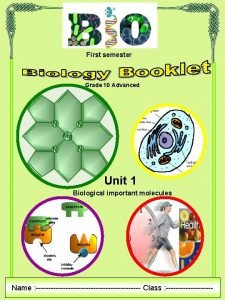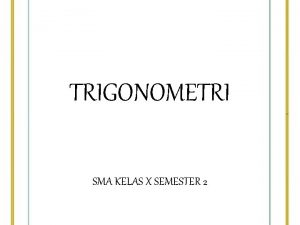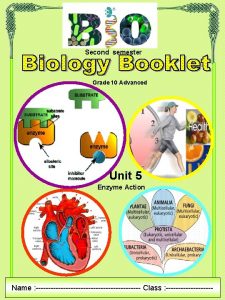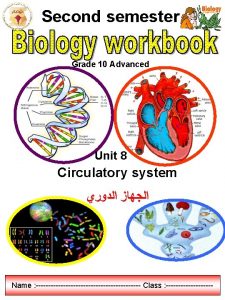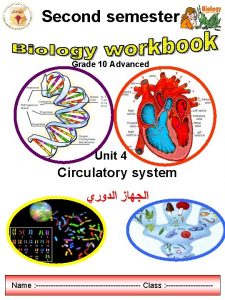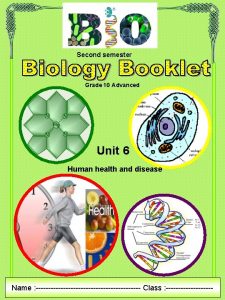Second semester Grade 10 Advanced Unit 7 Classification




























































- Slides: 60

Second semester Grade 10 Advanced Unit 7 Classification and Ecological Relationships Name : --------------------- Class : ----------

Booklet key This picture Grade 10 Biology Unit 8 – Diversity of life Means that this is a Key words links Exercises Reading text for improving language only


Grade 10 Biology Unit 8 – Diversity of life Contents ﺍﻟﻤﺤﺘﻮﻳﺎﺕ No. Pg Topic Unit 7 : Diversity of life History of classification …………………………… 2 Linnaeus’s system Taxonomical levels …………………. . 4 Binomial system ……………………. 7 The five kingdoms Monera ………………………… 17 Protista…………………………. 18 Fungi …………………………. . 19 Plantae………………………… 20 Animalia………………………… 21 The major phyla of animalia kingdom …………………. . 26 phyla of plantae kingdom …………………. . 39 Feeding Relationships…………………………… 47

Grade 10 Biology Unit 8 – Diversity of life Key Words Scientific term ﻣﻌﻨﻰ ﺍﻟﻤﺼﻄﻠﺢ Scientific term Prokaryota Family Protista Genus Fungi Species Animalia Binomial system Plantae Taxonomic hierarchy kingdom Community Phylum Producer Division Consumer Class Biomass Order Energy flow ﻣﻌﻨﻰ ﺍﻟﻤﺼﻄﻠﺢ 1

History of classification Grade 10 Biology Unit 7 – Diversity of life 10 A. 14. 1 Understand the term species, know that species can be placed in groups with shared features, and that the groupings of kingdom, phylum, class, order, family, genus and species form a hierarchy of classification. How many different kinds of organisms do you think live on Earth? Scientists have discovered about 1. 5 million different kinds of organisms so far. Because there are so many different kinds of organisms, scientists need to classify living things. The science of classifying living things is called Taxonomy. Scientists who classify living things are called taxonomists Classification is a way of organizing information about different kinds of organisms. Classifying living things also makes it easier to identify unknown organisms. For example, taxonomists can infer, or assume, that organisms with similar characteristics belong to similar groups. Classification also is a way to show relationships among organisms. One of the first known classification systems was developed more than 2000 years ago. The Greek philosopher and naturalist Aristotle classified organisms into two large groups – plants and animals. Aristotle then classified animals into smaller groups based upon where the animals lived. Aristotle had three groups of animals: land animals, water animals and air animals. ﺍﻷﺮﺽ؟ ﻛﻮﻛﺐ ﻋﻠﻰ ﺗﻌﻴﺶ ﺍﻟﻤﺨﺘﻠﻔﺔ ﺍﻟﺤﻴﺔ ﺍﻟﻜﺎﺋﻨﺎﺕ ﺃﻨﻮﺍﻉ ﻣﻦ ﻧﻮﻉ ﻛﻢ ﺭﺃﻴﻚ ﻓﻲ . ﺍﻵﻦ ﺣﺘﻰ ﺍﻟﺤﻴﺔ ﺍﻟﻜﺎﺋﻨﺎﺕ ﻣﻦ ﻧﻮﻋ ﻣﻠﻴﻮﻥ 1. 5 ﺣﻮﺍﻟﻲ ﺍﻟﻌﻠﻤﺎﺀ ﺍﻛﺘﺸﻒ ﻟﻘﺪ . ﺗﺼﻨﻴﻔﻬﺎ ﺇﻟﻰ ﻳﺤﺘﺎﺟﻮﻥ ﺍﻟﻌﻠﻤﺎﺀ ﻓﺈﻥ ، ﺍﻷﻨﻮﺍﻉ ﻣﺨﺘﻠﻔﺔ ﺍﻟﺤﻴﺔ ﺍﻟﻜﺎﺋﻨﺎﺕ ﻣﻦ ﺍﻟﻜﺜﻴﺮ ﻫﻨﺎﻙ ﻭﻷﻦ ﺍﻟﻜﺎﺋﻨﺎﺕ ﻫﺬﻩ ﻳﺼﻨﻔﻮﻥ ﺍﻟﺬﻳﻦ ﺍﻟﻌﻠﻤﺎﺀ ﻋﻠﻰ ﻭﻳﻄﻠﻖ. ” ﺍﻟﺘﺼﻨﻴﻒ ﺑﻌﻠﻢ ” ﺍﻟﺤﻴﺔ ﺍﻟﻜﺎﺋﻨﺎﺕ ﺗﺼﻨﻴﻒ ﻋﻠﻢ ﻋﻠﻰ ﻭﻳﻄﻠﻖ . ﺍﻟﺘﺼﻨﻴﻒ ﺑﻌﻠﻤﺎﺀ ﻣﻦ ﻣﺨﺘﻠﻔﺔ ﺃﻨﻮﺍﻉ ﺣﻮﻝ ﺍﻟﻤﻌﻠﻮﻣﺎﺕ ﻟﺘﻨﻈﻴﻢ ﻭﺳﻴﻠﺔ ﻫﻮ ﻓﺎﻟﺘﺼﻨﻴﻒ ﻣﻌﺮﻭﻓﺔ ﺍﻟﻐﻴﺮ ﺍﻟﻜﺎﺋﻨﺎﺕ ﺗﺤﺪﻳﺪ ﻳﺠﻌﻞ ﻭﺍﻟﺘﺼﻨﻴﻒ. ﺍﻟﺤﻴﺔ ﺍﻟﻜﺎﺋﻨﺎﺕ ﺃﻦ ﺍﻟﺘﺼﻨﻴﻒ ﻳﻔﺘﺮﺽ ، ﺍﻟﻤﺜﺎﻝ ﺳﺒﻴﻞ ﻓﻌﻠﻰ ، ﺳﻬﻼ ﺃﻤﺮ . ﻣﻤﺎﺛﻠﺔ ﺟﻤﺎﻋﺎﺕ ﺇﻟﻰ ﺗﻨﺘﻤﻲ ﺍﻟﻤﻤﺎﺛﻠﺔ ﺍﻟﺨﺼﺎﺋﺺ ﺫﺍﺕ ﺍﻟﺤﻴﺔ ﺍﻟﻜﺎﺋﻨﺎﺕ ﺑﻴﻦ ﺍﻟﻌﻼﻗﺎﺕ ﻹﻇﻬﺎﺭ ﻭﺳﻴﻠﺔ ﻓﻬﻮ ﺗﻄﻮﻳﺮﻩ ﺗﻢ ﻭﺍﻟﺬﻱ ﺍﻷﻮﻟﻰ ﺍﻟﻤﻌﺮﻭﻓﺔ ﺍﻟﺘﺼﻨﻴﻒ ﺃﻨﻈﻤﺔ ﺑﻴﻦ ﻣﻦ ﻭﻛﺎﻥ ﻭﺍﻟﺬﻱ ﺃﺮﺳﻄﻮ ﺍﻟﻴﻮﻧﺎﻧﻲ ﺍﻟﻔﻴﻠﺴﻮﻑ ﻗﺒﻞ ﻣﻦ ، ﺳﻨﺔ 2000 ﻣﻦ ﻷﻜﺜﺮ ﺍﻟﻨﺒﺎﺗﺎﺕ ﻣﺠﻤﻮﻋﺔ ، ﻣﺠﻤﻮﻋﺘﻴﻦ ﺇﻟﻰ ﺍﻟﺤﻴﺔ ﺍﻟﻜﺎﺋﻨﺎﺕ ﺗﺼﻨﻴﻒ ﻓﻴﻪ ﻳﺘﻢ ﻣﺠﻤﻮﻋﺎﺕ 3 ﺇﻟﻰ ﺍﻟﺤﻴﻮﺍﻧﺎﺕ ﺻﻨﻒ ﻭﻗﺪ. ﺍﻟﺤﻴﻮﺍﻧﺎﺕ ﻭﻣﺠﻤﻮﻋﺔ ﻭﺣﻴﻮﺍﻧﺎﺕ ﺑﺮﻳﺔ ﺣﻴﻮﺍﻧﺎﺕ ﺇﻟﻰ. ﻣﻌﻴﺸﺘﻬﺎ ﻣﻜﺎﻥ ﺃﺴﺎﺱ ﻋﻠﻰ ﺻﻐﻴﺮﺓ . ﺍﻟﻬﻮﺍﺀ ﻭﺣﻴﻮﺍﻧﺎﺕ ﻣﺎﺋﻴﺔ (300 B. C. ) ﺃﺮﺳﻄﻮ http: //www. cartage. org. lb/en/themes/sciences/zoology/biologicaldiverstity/classification. htm 2


Linnaeus’s System Grade 10 Biology Unit 7 – Diversity of life 1 -TAXONOMIC LEVELS ( Taxons ) Living things are classified into seven major groups, they are grouped in a hierarchy of 7 different taxonomic levels. : ﻣﺴﺘﻮﻳﺎﺕ ﺍﻟﺘﺼﻨﻴﻒ 1 - . ﻫﺮﻣﻲ ﺗﺴﻠﺴﻞ ﻓﻲ ﺗﺼﻨﻴﻔﻬﺎ ﻭﻳﺘﻢ ، ﺭﺋﻴﺴﻴﺔ ﻣﺴﺘﻮﻳﺎﺕ 7 ﺇﻟﻰ ﺍﻟﺤﻴﺔ ﺍﻟﻜﺎﺋﻨﺎﺕ ﺗﺼﻨﻒ ﺍﻟﻨﻮﻉ Species ﺍﻟﺠﻨﺲ Genus ﺍﻟﻌﺎﺋﻠﺔ Family ﺍﻟﺮﺗﺒﺔ Order ﺍﻟﻄﺎﺋﻔﺔ Class ﺍﻟﺸﻌﺒﺔ Phylum ﺍﻟﻤﻤﻠﻜﺔ Kingdom http: //www. cactus-art. biz/note-book/Dictionary_T/dictionary_taxonomic_groups. htm 4

Grade 10 Biology Unit 7 – Diversity of life 5

Examples from life Kingdom Animalia Phylum Chordata Class Mammalia Order Primates Family Hominidae Genus Homo Species Sapiens Kingdom Animalia Phylum Chordata Class Mammalia Order Carnivora Family Felidae Genus Panthera Species Leo Kingdom Plantae Division Magnoliophyta Class Magnoliopsida Order Rosales Family Rosaceae Genus Rosoideae Species Rosa Grade 10 Biology Unit 7 – Diversity of life 6

Species Grade 10 Biology Unit 7 – Diversity of life ﺍﻷﻨﻮﺍﻉ is the ability to produce fertile offspring. ( ﻋﻘﻴﻤﺔ ﻏﻴﺮ ) ﻣﺨﺼﺒﺔ ﺃﺠﻴﺎﻝ ﺇﻧﺘﺎﺝ ﻋﻠﻰ ﺍﻟﻘﺪﺭﺓ ﻫﻲ Lion + + Lioness Tiger 2 - BINOMIAL System: Linnaeus developed a system for naming living things called the “ Binomial System “, in this system, each kind of organism is identified by a two-part scientific name. Binomial is the system still used today. The first part is the name of the genus and the second part is the name of the species. ﺍﻟﻨﻈﺎﻡ ﻫﺬﺍ ﻭﻓﻲ ، (( ﺍﻟﺜﻨﺎﺋﻴﺔ ﺍﻟﺘﺴﻤﻴﺔ ﻧﻈﺎﻡ )) ﺍﻟﻨﻈﺎﻡ ﻫﺬﺍ ﻋﻠﻰ ﻭﻳﻄﻠﻖ ، ﺍﻟﺤﻴﺔ ﺍﻟﻜﺎﺋﻨﺎﺕ ﻟﺘﺴﻤﻴﺔ ﻧﻈﺎﻣ ﻟﻴﻨﻴﻮﺱ ﻃﻮﺭ ﺇﻟﻰ ﺍﻷﻮﻝ ﺍﻟﻤﻘﻄﻊ ﻭﻳﺸﻴﺮ ، ﻫﺬﺍ ﻳﻮﻣﻨﺎ ﺣﺘﻰ ﻳﺴﺘﺨﺪﻡ ﻭﻻﺯﺍﻝ ، ﻣﻘﻄﻌﻴﻦ ﻣﻜﻮﻥ ﻋﻠﻤﻴ ﺍﺳﻤ ﺣﻲ ﻛﺎﺋﻦ ﻟﻜﻞ ﻳﻜﻮﻥ ﺍﻟﻨﻮﻉ ﺇﻟﻰ ﻭﺍﻟﺜﺎﻧﻲ ﺍﻟﺠﻨﺲ Ursus arctos Ursus maritimus Ursus americanis 7

Naming rules : Grade 10 Biology Unit 7 – Diversity of life 1 - Name should be in two parts with Latin to be popularly known as the "Latin name”. 2 - First name is Genus and second is species, the first letter in genus should be written with a capital letter. 3 - Binomial should be printed in a (font) different from that used in the normal text when handwritten or underlined; for example, Homo sapiens. Each name should be underlined individually. : ﻗﻮﺍﻋﺪ ﺍﻟﺘﺴﻤﻴﺔ . ﺍﻟﻼﺗﻴﻨﻴﺔ ﻭﺑﺎﻟﻠﻐﺔ ﻣﻘﻄﻌﻴﻦ ﻣﻦ ﺍﻟﻌﻠﻤﻲ ﺍﻻﺳﻢ ﻳﺘﻜﻮﻥ ﺃﻦ ﻳﺠﺐ 1. ﻛﺒﻴﺮ ﺑﺤﺮﻑ ﺍﻟﺠﻨﺲ ﻳﺒﺪﺃ ﺃﻦ ﻭﻳﺠﺐ ، ﺍﻟﻨﻮﻉ ﺇﻟﻰ ﻭﺍﻟﺜﺎﻧﻲ ﺍﻟﺠﻨﺲ ﺇﻟﻰ ﺍﻷﻮﻝ ﺍﻟﻤﻘﻄﻊ ﻳﺸﻴﺮ 2 ﻣﻊ ، ﻭﺍﻟﻨﻮﻉ ﺍﻟﺠﻨﺲ ﺃﺴﻔﻞ ﺧﻂ ﺑﻮﺿﻊ ﺃﻮ ﺍﻟﻨﺺ ﻋﻦ ﻳﺨﺘﻠﻒ ﻋﺮﻳﺾ ﺑﺨﻂ ﺍﻟﻌﻠﻤﻲ ﺍﻻﺳﻢ ﻳﻜﺘﺐ ﺃﻦ ﻳﺠﺐ 3 Homo sapiens : ﻣﺜﺎﻝ ، ﺣﺪﺓ ﻋﻠﻰ ﻣﻘﻄﻊ ﻛﻞ ﺃﺴﻔﻞ ﺧﻂ ﻭﺿﻊ ﻣﺮﺍﻋﺎﺓ http: //www. botany. hawaii. edu/faculty/wong/bot 135/lect 04. htm 8


Grade 10 Biology Unit 7 – Diversity of life 1 Binomial system : ﻧﻈﺎﻡ ﺍﻟﺘﺴﻤﻴﺔ ﺍﻟﺜﻨﺎﺋﻴﺔ -------------------------------------------------------------------------------------------------------- For example : Ursus arctos Ursus maritimus Ursus americanis Naming rules : ﺍﻟﺘﺴﻤﻴﺔ ﻗﻮﺍﻋﺪ 1 - 2 - 3 - 10

2 Grade 10 Biology Unit 7 – Diversity of life Taxonomic levels: (TAXONS) ﺍﻟﺘﺼﻨﻴﻒ ﻣﺴﺘﻮﻳﺎﺕ Organisms are grouped in a hierarchy of ------- different taxonomic levels ﻣﺨﺘﻠﻔﺔ ﺗﺼﻨﻴﻔﻴﺔ ﻣﺴﺘﻮﻳﺎﺕ ------ ﻝ ﺍﻟﻬﺮﻣﻲ ﺍﻟﺘﺴﻠﺴﻞ ﻓﻲ ﺍﻟﺤﻴﺔ ﺍﻟﻜﺎﺋﻨﺎﺕ ﺗﺼﻨﻒ King Philip Counts Our Family Gold and Silver ----------------------------------------- 11

Grade 10 Biology Unit 7 – Diversity of life --------------------------------------------------------------- Kingdom 12


Grade 10 Biology Unit 7 – Diversity of life Activity 1 Classify the following organisms according to what you think, Then try to name each group according to your classification : : ﺍﻟﺨﺎﺹ ﻟﺘﺼﻨﻴﻔﻚ ﻭﻓﻘﺎ ﻣﺠﻤﻮﻋﺔ ﻛﻞ ﺗﺴﻤﻴﺔ ﺣﺎﻭﻝ ﺛﻢ ، ﺭﺃﻴﻚ ﺣﺴﺐ ﺍﻟﺘﺎﻟﻴﺔ ﺍﻟﺤﻴﺔ ﺍﻟﻜﺎﺋﻨﺎﺕ ﺻﻨﻒ Dog Pineapple Euglena Bread mold Mushroom Elephant Amoeba Bacteria Carrot Blue green bacteria Human Snake Flower pencilium Paramecium Fish Corn 14


Grade 10 Biology Unit 7 – Diversity of life Kingdoms http: //www. ruf. rice. edu/~bioslabs/studies/invertebrates/kingdoms. html 16






Lesson 2 Grade 10 Biology Unit 7 – Diversity of life The five kingdoms ﺍﻟﻤﻤﺎﻟﻚ ﺍﻟﺨﻤﺴﺔ 22



Grade 10 Biology Unit 7 – Diversity of life Home work 1 Complete the following table: ﺍﻟﺘﺎﻟﻲ ﺍﻟﺠﺪﻭﻝ ﺃﻜﻤﻞ Kingdom ﻣﻤﻠﻜﺔ Distinguishing features ( 2 at least ) ﻣﻤﻠﻜﺔ ﻟﻜﻞ ﻣﻤﻴﺰﺗﻴﻦ ﺻﻔﺘﻴﻦ ﺍﻛﺘﺐ Write the name of kingdom under each example: ﻣﺜﺎﻝ ﻛﻞ ﺗﺤﺖ ﺍﻟﻤﻤﻠﻜﺔ ﺍﺳﻢ ﺍﻛﺘﺐ 25

Grade 10 Biology Unit 7 – Diversity of life The Major phyla of Animalia kingdom ﺍﻟﺸﻌﺐ ﺍﻟﺮﺋﻴﺴﻴﺔ ﻟﻤﻤﻠﻜﺔ ﺍﻟﺤﻴﻮﺍﻥ 10 A. 14. 3 Use knowledge of the key features of the major phyla of animals and plants to recognise a typical member. There are 9 major phyla in the kingdom Animalia. See below. . ﺃﺴﻔﻞ ﺍﻟﻤﺨﻄﻂ ﻓﻲ ﻣﻮﺿﺢ ﻫﻮ ﻛﻤﺎ ﺍﻟﺤﻴﻮﺍﻥ ﻟﻤﻤﻠﻜﺔ ﺭﺋﻴﺴﻴﺔ ﺷﻌﺐ 9 ﻫﻨﺎﻙ http: //waynesword. palomar. edu/trnov 01. htm 26























Grade 10 Biology Unit 7 – Diversity of life Food web ﻏﺬﺍﺋﻴﺔ ﻟﺸﺒﻜﺔ ﻧﻤﻮﺫﺝ 49






Grade 10 Biology Unit 8 – Diversity of life 3 - Read the text below then summarize it. ﺛﻢ ﻟﺨﺼﻪ ﺑﺄﺴﻠﻮﺑﻚ ، ﺍﻗﺮﺃ ﺍﻟﻨﺺ ﺍﻟﺘﺎﻟﻲ 10 minutes (max) REA DI ACTI NG VITY Taxonomy is that branch of biology dealing with the identification and naming of organisms. The ancient Greek philosopher Aristotle apparently began the discussion on taxonomy. British naturalist John Ray is credited with revising the concept of naming and describing organisms. During the 1700 s, Swedish botanist Carolus Linneus classified all then-known organisms into two large groups: the kingdoms Plantae and Animalia. Robert Whittaker in 1969 proposed five kingdoms: Plantae, Animalia, Fungi, Protista, and Monera. Other schemes involving an even greater number of kingdoms have lately been proposed, however most biologists employ Whittaker's five kingdoms. Recent studies suggest that three domains be employed: . Archaea, Bacteria, and Eukarya ……………………………………………………………… 55

Grade 10 Biology Unit 8 – Diversity of life 1 - Globe Biology ( Annotated Teachers Edition ) 2 - Biology ( Prentice Hall ) 3 - Advanced Biology For You. 48
 Cinderella jump rope song
Cinderella jump rope song Difference between lytic and lysogenic cycle
Difference between lytic and lysogenic cycle Biology grade 10 unit 1
Biology grade 10 unit 1 Advanced word power second edition answers
Advanced word power second edition answers Ten steps to advanced reading answer key
Ten steps to advanced reading answer key 27 miles per gallon into kilometers per liter
27 miles per gallon into kilometers per liter Chemistry semester 2 review unit 12 thermochemistry
Chemistry semester 2 review unit 12 thermochemistry Unit 6 review questions
Unit 6 review questions Classroom rules for second grade
Classroom rules for second grade Second grade homework
Second grade homework Authors purpose second grade
Authors purpose second grade Second grade economics
Second grade economics Wjec criminology unit 4 revision
Wjec criminology unit 4 revision Wjec criminology unit 4 revision
Wjec criminology unit 4 revision Advanced higher biology unit 1
Advanced higher biology unit 1 Higher biology photosynthesis
Higher biology photosynthesis Advanced higher biology unit 2
Advanced higher biology unit 2 Sex determination in drosophilla
Sex determination in drosophilla Raw grade to transmuted
Raw grade to transmuted Difference between grade a and grade aa eggs
Difference between grade a and grade aa eggs Grades of milk
Grades of milk Grade grade
Grade grade Meta - change morph -
Meta - change morph - What is matter grade 7
What is matter grade 7 Materi sosiologi kelas 12 semester 1
Materi sosiologi kelas 12 semester 1 Materi desain grafis kelas 10 semester 2
Materi desain grafis kelas 10 semester 2 Fall semester exam review us history
Fall semester exam review us history Tugas tik kelas 9 semester 2
Tugas tik kelas 9 semester 2 Materi tik kelas 8 semester 2
Materi tik kelas 8 semester 2 Terompet gitar dan suling merupakan contoh sumber energi
Terompet gitar dan suling merupakan contoh sumber energi Materi ips sd kelas 6
Materi ips sd kelas 6 Oidd major wharton
Oidd major wharton English 3 semester exam
English 3 semester exam English 11 semester exam
English 11 semester exam Materi segitiga smp kelas 7 semester 2
Materi segitiga smp kelas 7 semester 2 Materi esensial ips kelas 9
Materi esensial ips kelas 9 Ppt prakarya dan kewirausahaan kelas xi semester 1
Ppt prakarya dan kewirausahaan kelas xi semester 1 Modus matematika
Modus matematika Materi mice kelas 11 semester 2
Materi mice kelas 11 semester 2 Serat pupuh wulangreh kaanggit dening
Serat pupuh wulangreh kaanggit dening Imprest fund system adalah
Imprest fund system adalah Fungsi mencari dana
Fungsi mencari dana Media pembelajaran matematika sma
Media pembelajaran matematika sma Materi agama katolik kelas 12 semester 2
Materi agama katolik kelas 12 semester 2 Mencari tokoh-tokoh beriman dalam alkitab ibrani 11
Mencari tokoh-tokoh beriman dalam alkitab ibrani 11 Honors physics semester 1 review
Honors physics semester 1 review Sketsa 2/3 sudut siku siku
Sketsa 2/3 sudut siku siku World history semester 2 final review packet
World history semester 2 final review packet World history semester exam
World history semester exam Environmental science final
Environmental science final Earth science semester 2 final exam answers
Earth science semester 2 final exam answers Teoretisk forudsætningskrav eksempel
Teoretisk forudsætningskrav eksempel Clock hour to credit hour conversion
Clock hour to credit hour conversion Materi pjok kelas 6 semester 1 atletik
Materi pjok kelas 6 semester 1 atletik Us history semester 2 final exam
Us history semester 2 final exam Algebra 2 semester 2 final exam
Algebra 2 semester 2 final exam Unsw calendar 2022
Unsw calendar 2022 Uf law externship
Uf law externship Tugas prakarya kelas 11
Tugas prakarya kelas 11 Trigonometri kelas 10 semester 2
Trigonometri kelas 10 semester 2 Kompetensi dasar fisika kelas 11
Kompetensi dasar fisika kelas 11


